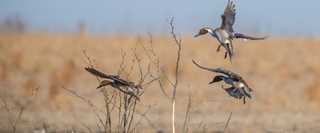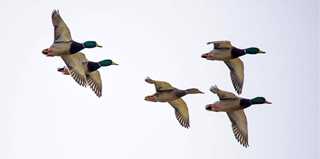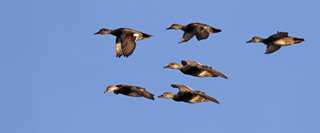2017 Waterfowl Forecast
Another large fall flight is expected as duck and goose populations remain strong
Another large fall flight is expected as duck and goose populations remain strong

This year's waterfowl survey results were released in mid-August, and once again the report contained good news for hunters and other waterfowl enthusiasts. According to the U.S. Fish and Wildlife Service (USFWS), duck numbers in the traditional survey area were statistically similar to the 2016 estimate. The total population was estimated at 47.3 million breeding ducks, which was 34 percent above the 1955minus;2016 average and the fifth largest estimate on record. With the exception of northern pintails and scaup, populations of the 10 most abundant duck species were near or above their long-term averages (see chart). In addition, the projected mallard fall flight index is 12.9 million birds, similar to the 2016 estimate of 13.5 million birds.
When ducks and geese returned to the breeding grounds this past spring, they found improved wetland conditions on many important waterfowl breeding areas. May ponds-the unit of measure for wetland abundance on the prairies-increased 22 percent, from just over 5 million ponds in 2016 to almost 6.1 million ponds this spring. The total May pond count was 17 percent above the long-term average, largely due to carryover water stored in wetland basins from the previous summer and fall.
"The surveys indicate that wetland conditions and populations of most frequently harvested ducks remain above the long-term average. There were some declines in several species from last year, but generally hunters are not likely to notice that annual variation out in the field, especially if timely cold winter weather develops in northern and mid-latitude areas of the continent," said DU Chief Scientist Dr. Tom Moorman. "This is great news for waterfowlers, who can now turn their attention to preparing habitat, tuning up dogs, and relentlessly watching the weather forecasts for the onset of fall and winter weather that will push the birds on their annual southward migration."
Although annual changes in duck and goose numbers have important implications for waterfowlers, they do not necessarily influence individual hunting success. Weather and local habitat conditions often affect the fortunes of waterfowlers more than the size of the fall flight, especially in migration and wintering areas. With that in mind, the following is an overview of waterfowl populations in each flyway, based on reports from biologists in the field.

The Pacific Flyway receives most of its waterfowl from the western United States and Canada, with the majority of ducks and geese coming from Alberta, British Columbia, the Yukon, the Northwest Territories, Alaska, and other western states. In southern Alberta, an estimated 6.4 million breeding ducks were surveyed this spring-a 28 percent increase from the 2016 estimate and 49 percent above the long-term average.
"The breeding season started with average to above-average spring runoff and cool, wet conditions that may have delayed early breeding efforts," reports Ian McFarlane, a biologist with DU Canada. "Summer precipitation was near normal in the south, but temperatures have been high, which has decreased water levels. However, semipermanent wetlands remain full in the aspen parkland and Boreal transition zone. There was a good late hatch and numerous large broods have been reported by our field staff."
Farther north, in the Boreal Forest of northern Alberta, northeastern British Columbia, and the Northwest Territories, an estimated 11.4 million breeding ducks were surveyed this spring-a 19 percent decrease from the previous year's estimate. However, breeding duck numbers in this vast survey area remained 54 percent above the long-term average. In Alaska and the Yukon, this year's population of 4 million breeding ducks was similar to both the 2016 estimate and the long-term average.
DU Canada biologist Jamie Kenyon reports that wetland conditions were generally favorable for breeding waterfowl across much of the Western Boreal Forest. "This summer's weather has been varied, but brood production has been good overall. Northern Alberta, the Northwest Territories, and the northern Yukon have had above-normal temperatures and below-average precipitation, but ponds remain full," Kenyon says. "In the southern Yukon and northeast British Columbia, cool, wet conditions have maintained high water levels."
In the United States, above-average precipitation improved wetland conditions across much of the West following several years of severe drought. In California, improved production of mallards, gadwalls, and cinnamon teal was expected following one of the wettest winters on record. In Oregon, breeding duck numbers were similar to last year's estimate and the long-term average, while in Washington, total ducks were up dramatically compared to both last year's estimate and the long-term average.
The outlook is good for Pacific Flyway goose populations. Weather and habitat conditions were generally favorable for breeding geese in Alaska, and large fall populations of cackling, Ross's, lesser snow, and white-fronted geese are expected. Surveys indicate that Pacific brant numbers were similar to last year's estimates and the 10-year average.

Central Flyway waterfowl are raised on the prairies of the United States and Canada as well as in the Western Boreal Forest and the Arctic. Saskatchewan consistently ranks at the top of North America's most important waterfowl breeding areas, and this year was no exception. Almost 12.2 million breeding ducks were surveyed across the vast grasslands and parklands of this province-a 13 percent increase from the 2016 estimate and a level 53 percent above the long-term average.
According to DU Canada biologist Kelly Rempel, dry weather took a toll on small, shallow wetlands in the province this summer, but sufficient habitat remained on the landscape to support breeding waterfowl. "Limited moisture and high temperatures since May have dried temporary and seasonal ponds. However, water levels in larger semipermanent wetlands, which began to draw down in early July, continued to provide good habitat for hens and broods," Rempel says. "Mallard, blue-winged teal, gadwall, and northern shoveler broods were abundant in areas with suitable habitat."
Good spring wetland conditions were also initially reported in the Great Plains states. In the eastern Dakotas, breeding duck numbers were similar to the 2016 estimate and remained 32 percent above the long-term average. In the western Dakotas and Montana, duck numbers were also unchanged from last year's and were 28 percent above the long-term average. Unfortunately, the onset of exceptionally hot, dry weather in June and July likely had a negative impact on waterfowl breeding success across the region.
"Severe drought returned to the Prairie Pothole Region of the Dakotas and northeastern Montana this summer," reports Dr. Johann Walker, DU's director of conservation programs in North Dakota, South Dakota, and Montana. "Although carryover water in larger wetlands and five years of above-average breeding populations resulted in some waterfowl production this year, the region's contribution to the fall flight will likely be smaller than in recent years."
Another bumper crop of geese is expected in the Central Flyway this fall. According to the USFWS, average to above-average production was expected for lesser snow, white-fronted, and Ross's geese in 2017. Good production was expected for Arctic-nesting Canada geese, while typical production was anticipated for prairie-breeding birds.

The Mississippi Flyway receives most of its waterfowl from the Prairie Pothole Region, as well as from Ontario, the Great Lakes states, the Western Boreal Forest, and the Arctic. In southern Manitoba, abundant carryover water resulted in a 10 percent increase in May ponds compared to the 2016 estimate. Total breeding duck numbers were essentially unchanged from the previous year's estimate, and were 13 percent above the long-term average.
"In the southwest, where a large proportion of Manitoba's waterfowl are raised, nest initiation was early this spring, with the first mallard broods observed in late May and the first blue-winged teal broods observed in mid-June," reports DU Canada biologist Mark Francis. "Dry weather has prevailed this summer, and water levels in wetlands are now receding, although ample habitat remains to support broods."
Conditions are much different in neighboring Ontario, where unusually wet weather has left wetlands brimming with water. "Precipitation has been abundant this summer, maintaining water levels in ephemeral ponds and providing good habitat for breeding waterfowl," reports DU Canada biologist David McLachlin. "Cool, wet weather delayed hay cutting in the south and east, which may have benefited renesting mallards and late-nesting waterfowl species."
Mallards and other ducks raised in the Great Lakes states are an important component of the waterfowl harvest in the eastern Mississippi Flyway and in the mid-Atlantic states. In Michigan, Wisconsin, and Minnesota, mallard numbers were similar to 2016 estimates and their long-term averages. Total duck numbers were up in Michigan and Wisconsin, while in Minnesota the population was down from the previous year's estimate.
"Favorable wetland conditions were present during the brood-rearing period across much of the Great Lakes states this summer," says Dr. John Coluccy, director of conservation planning in DU's Great Lakes/Atlantic Region. "These conditions should have resulted in good brood habitat and renesting opportunities for mallards and other waterfowl species."
The outlook for Mississippi Flyway goose populations is mixed. The Mississippi Flyway Interior Population of Canada geese was up 10 percent in the main survey area in 2017. However, spring was late arriving on western Hudson and James Bays, and field reports suggest that goose production may have been slightly below average as a result. Nearly 1.8 million giant Canada geese were surveyed in the Mississippi Flyway, and good to excellent production was expected for this population. Surveys indicate that breeding success among midcontinent lesser snow and white-fronted geese was good, and large fall populations of these birds are expected.

The majority of Atlantic Flyway waterfowl are raised in the northeastern United States and Canada, although this flyway also receives large numbers of dabbling ducks and divers from the prairies. In 2017, the total breeding duck population estimate for the six most abundant species in the eastern survey area (covering eastern Ontario, Quebec, Atlantic Canada, Maine, and northern New York) was 2.6 million birds. This year's estimate of approximately 500,000 American black ducks was similar to last year's, but was 12 percent below the 1990minus;2016 average. Populations of mallards, American green-winged teal, and goldeneyes were similar to last year's estimates and their long-term averages. And ring-necked ducks were down 19 percent from last year's estimate, but remained near the long-term average. Approximately 1.3 million breeding ducks were surveyed in the northeastern United States, similar to last year's total and the long-term average.
DU Canada biologist Nic McLellan reports that wetland conditions were generally favorable for waterfowl production in Atlantic Canada (New Brunswick, Nova Scotia, and Prince Edward Island), a key breeding area for black ducks and many other waterfowl species. "Although waterfowl nesting efforts were delayed this spring due to high water levels, observations from the field indicate that brood sizes appear to be large this year," McLellan says. "Summer precipitation has been near average across much of this region, and water levels are currently stable, providing favorable habitat for brood rearing."
The forecast for Atlantic Flyway goose populations is variable. The breeding pair estimate for Atlantic Population Canada geese was similar to last year's estimate and the long-term average, and these birds were expected to have fair to good production this summer. Just over 930,000 resident Canada geese were surveyed in the Atlantic Flyway, and production was expected to be good to excellent for this population. In the eastern Canadian Arctic, greater snow goose numbers were down 18 percent this year, and average production was expected. Atlantic brant numbers were similar to those of 2016, and surveys indicate that breeding success was variable for these birds.
About the Survey
Each year, biologists with the U.S. Fish and Wildlife Service, Canadian Wildlife Service, state and provincial wildlife agencies, and nonprofit conservation organizations including Ducks Unlimited take part in the Waterfowl Breeding Population and Habitat Survey-the world's longest-running and most comprehensive wildlife population survey. These dedicated men and women physically count ducks and geese by air and on foot along thousands of miles of standardized survey transects from South Dakota to Alaska. The information collected during this survey has been the cornerstone of waterfowl harvest management in North America for more than 60 years. For more information about this year's survey results, visit flyways.us.
Ducks Unlimited uses cookies to enhance your browsing experience, optimize site functionality, analyze traffic, and deliver personalized advertising through third parties. By continuing to use this site, you agree to our use of cookies. View Privacy Policy